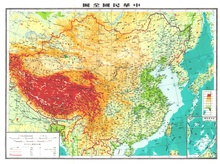This article needs additional citations for verification. (January 2018) |
You can help expand this article with text translated from the corresponding article in Chinese. (December 2018) Click [show] for important translation instructions.
|
Jiangxinpo (Chinese: 江心坡) was an area currently in Kachin State, Myanmar, located between the N'Mai and Mali Rivers, west of the Gaoligong Mountains of Yunnan, China. It was previously under the rule of the Qing dynasty of China.




In 1910, a year before Republic of China (ROC) was established, the British occupied Hpimaw[1] (片馬/片马; Piànmǎ)[2] in the Pianma Incident, as well as a part of what is now Northern Kachin state in 1926-27 and part of the Wa states in 1940.[3][4]
It was disputed territory between China and Myanmar until 1961, when People's Republic of China (PRC) recognized Myanmar's sovereignty over it,[1] with the exception of Burma relinquishing small amount of that territory,[5] namely Hpimaw (Pianma) and adjacent Gawlam (Gulang) (古浪; Gǔlàng)[6] and Kangfang[1] (崗房; 岗房; Gǎngfáng)[7] to PRC, as part of Lushui county. Some Chinese commentators, especially those media in ROC (Taiwan)[1] and overseas which are outside the control of PRC government's censorship, criticized the PRC government for signing the agreement, which they regarded as guaranteeing the permanent loss of former Chinese territory to Myanmar.
See also
edit- Kachin Hills
- Pianma Incident
- Sino–Burmese 1960 border treaty
- Putao (葡萄) (ပူတာအို)
- Hukawng Valley (胡康/胡岡) (ဟူးကောင်းချိုင့်ဝှမ်း)
- Namkham (南坎) (နမ့်ခမ်းမြို့)
- Former Yunnan Province, Republic of China
References
edit- ^ a b c d "International Boundary Study No. 42 – Burma-China Boundary" (PDF). US DOS. 30 November 1964. p. 11. Archived from the original (PDF) on 31 January 2020. Retrieved 17 September 2020.
1961 agreements remove the causes of boundary friction between Burma and the Communist regime on the Chinese mainland. They do not eliminate the dispute between Burma and the Republic of China
- ^ "Lúshuǐ Xiàn Piànmǎ Zhèn Piànmǎ Cūnwěihuì Xiàpiànmǎ Cūn" 泸水县片马镇片马村委会下片马村 [Xiapianma Village, Pianma Village Committee, Pianma Town, Lushui County]. ynszxc.gov.cn (in Chinese). Archived from the original on 2015-04-02.
- ^ Gillogly, Kathleen (2006). "Transformations of Lisu Social Structure Under Opium Control and Watershed Conservation in Northern Thailand" (PDF). evols.library.manoa.hawaii.edu. Archived from the original (PDF) on 2013-09-21. Retrieved 2020-09-13.
- ^ "Yunnan | province, China". Encyclopedia Britannica. Retrieved 2023-10-30.
In 1910 the British, then established in Burma, induced the tusi of Pianma (Hpimau) to defect from the central Chinese government, and they then occupied his territory in northwestern Yunnan. Britain also forced China to give up a tract of territory in what is now the Kachin state of Myanmar (1926–27), as well as the territory in the Wa states (1940).
- ^ "International Boundary Study No. 42 – Burma-China Boundary" (PDF). USDOS. 30 November 1964. Archived from the original (PDF) on 31 January 2020. Retrieved 17 September 2020.
Agreement on the Question of the Boundary signed on January 28, 1960...(b) the villages of Hpimaw, Gawlum, and Kangfang would be Chinese;...(d) the Panhung-Panlao tribal area would be exchanged (for Namwan); and (e) with the exception of d, the 1941 boundary in the Wa states would be accepted...
- ^ "Lúshuǐ Xiàn Piànmǎ Zhèn Gǔlàng Cūnwěihuì" 泸水县片马镇古浪村委会 [Gulang Village Committee, Pianma Town, Lushui County]. ynszxc.gov.cn (in Chinese). Archived from the original on 2015-04-03.
- ^ "Lúshuǐ Xiàn Piànmǎ Zhèn Gǎngfáng Cūnwěihuì" 泸水县片马镇岗房村委会 [Gangfang Village Committee, Pianma Town, Lushui County]. ynszxc.gov.cn (in Chinese). Archived from the original on 2015-04-02.